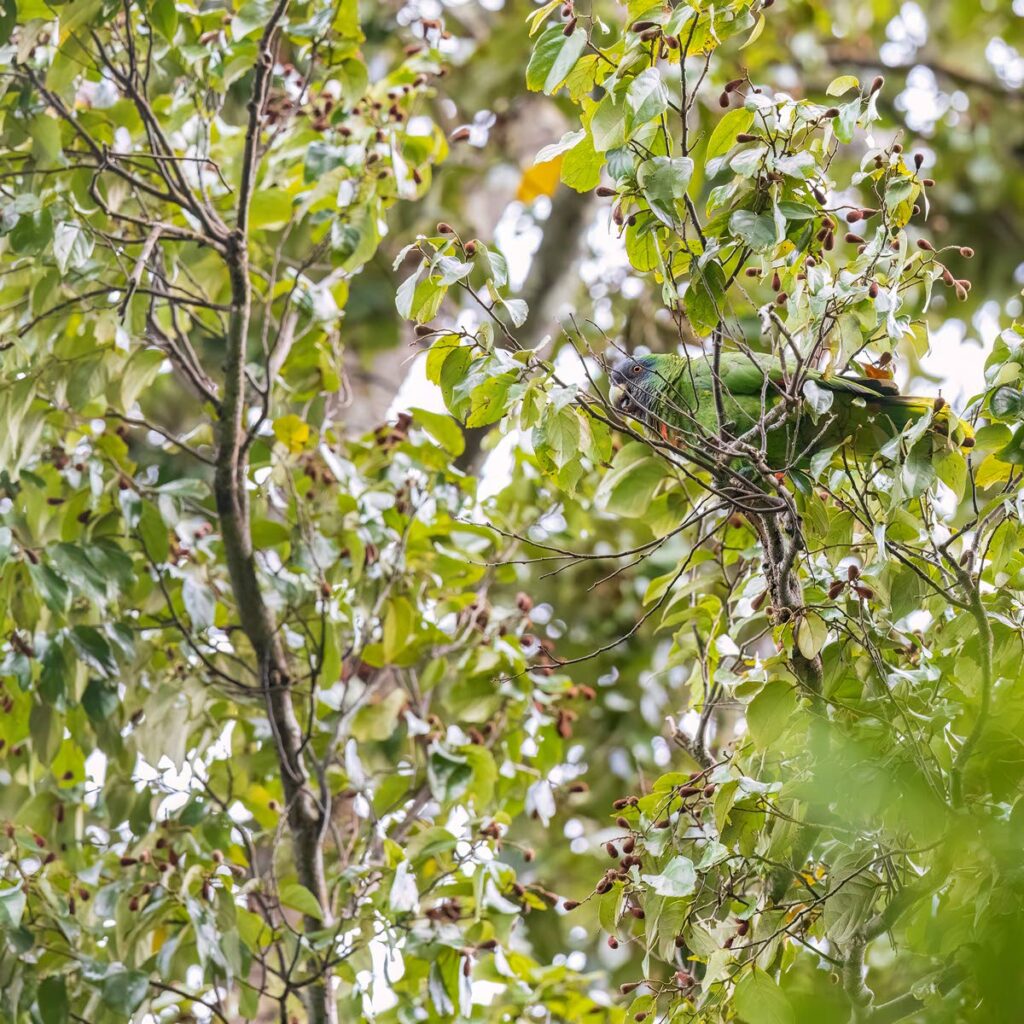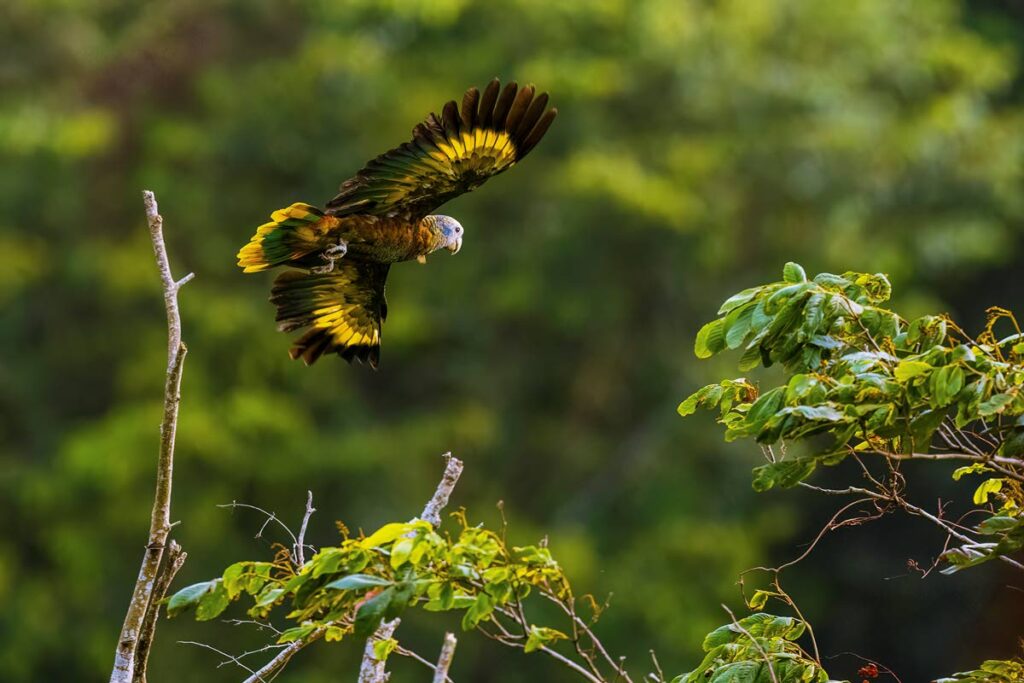Endangered in the Antilles

Falcons, parrots, parakeets are all near neighbours according to Faraaz Abdool who considers the fates of native parrots on some islands of the Lesser Antilles. All photos courtesy Faraaz Abdool
For those of us familiar with the budgerigar – colloquially known as “budgie” – they are built for flight much like falcons are. Long, tapered wings and a long tail propel and guide a bullet-shaped body with ease at bone-shattering speeds. Even the mint-green rose-ringed parakeet, Europe’s first introduction to this family courtesy Alexander the Great in 327AD, shares these characteristics.
Delving deeply into the most recent revisions of avian taxonomy, one would encounter a pair of surprising neighbours. Falcons, within the order Falconiformes, famous for their blistering speed and ruthless accuracy, sit adjacent to Psittaciformes: parrots, cockatoos, and their relatives. Indeed, all these birds lie along the same spectrum. A look at budgerigars in their thousands whirling and diving to avoid the talons of an ardent black falcon in the Australian outback would undoubtedly cement the ancient link between the two.
Here in the Neotropics there are no budgerigars or cockatoos, but there are macaws, parrots, parakeets, and the smallest of them all, parrotlets. European explorers encountered indigenous peoples with psittacine companions; personable and desirous of social contact on a consistent basis, many of these birds were transported to Europe, rekindling interest in parrot-keeping. By the 18th century, the keeping of parrots in cages was a well-patronised trend, one which persists to the present.
Today it is well known that most species are in a serious existential crisis. The most common culprits are anthropogenic in origin; habitat loss and hunting are typically the top two reasons any species teeters on the brink of extinction. Piling on pressures of the pet trade adds another weight to the scale that is already tipping over towards an undesirable outcome. Within the order Psittaciformes, just about half of the species are either under threat of extinction, or already extinct. They are undoubtedly one of the most imperilled families of birds on the planet. Fortunately in some of the islands of the Lesser Antilles, there are ardent conservation efforts to save several emblematic parrot species from permanent erasure.
The parrots of the Lesser Antilles all lie within the Amazona genus of parrots, not unlike the orange-winged parrot that is found throughout Trinidad and Tobago. The nature of these islands leads to a high degree of endemism, and many are thought to have at least once had an endemic species of Amazona parrot! The French islands of Martinique and Guadeloupe have sadly already lost their respective parrots: Martinique parrot and Guadeloupe parrot, both with final records in 1779. Hunting was cited as the principal culprit behind their demise.
Clinging to co-exist
In nearby Dominica, a pair of species clings to existence. Both are endemic to this mountainous and heavily forested island, but one is faring significantly better than the other. The smaller of the two is the red-necked parrot, which is currently listed as vulnerable to extinction. They aren’t particularly small, however, medium-sized would be more accurate. Relying primarily on large, mature trees for nesting, red-necked parrots are negatively impacted by powerful hurricanes that fell these trees. Concerted conservation in the island has led to a resurgence in their population. Two hurricanes in consecutive years (1979 and 1980) whittled the population of red-necked parrots down to approximately 200 birds. Today, optimistic estimates put their population closer to 1,000.

Red-necked parrots share a small portion of their range with the near-mythical imperial parrot, called Sisserou. The largest member of the Amazona genus is extremely difficult to find within the high-elevation forest on Dominica’s northern end. This massive bird is critically endangered and currently numbers are estimated at around 150 individuals. Ornithologists held their collective breath after the Category 5 storm in 1980 which left approximately 40 imperial parrots alive. Being slow breeders and heavily reliant on mature forests – prime targets for deforestation – the imperial parrot was slow to recover. But recover it did, population estimates identified up to more than 300 birds prior to Hurricane Maria in 2017.
Further south, the island of St Lucia is home to another endemic Amazona parrot that bears the name of the island itself. The St Lucia parrot is a strikingly beautiful bird with a blue head, gradually giving way to a bright green body. The bird boasts a rosy red breast and belly. The population of St Lucia parrots was estimated at around 1,000 in 1950 but fell to a treacherous 150 birds in 1970. Hunting and habitat loss were major contributing factors to this precipitous decline, but sterling conservation awareness programmes and outreach since 1970 have allowed an increase to approximately, and optimistically, 500. Nevertheless, the desire of the increasing human population on St Lucia for land space has resulted in the available St Lucia Parrot habitat being slashed by 50 per cent since 1950. Consequently, the St Lucia parrot remains listed as Vulnerable to extinction.
Keeping iconic birds alive
On neighbouring St Vincent, a cosquelle-plumaged parrot is experiencing a slightly different fate. Endemic to the island which bears its name, the St Vincent parrot does not immediately look as if it should be a parrot. After all, there is exceptionally little green on its body. Predominantly bronze with a white head and a blue spot behind the eye, the St Vincent parrot looks decidedly different from all other members of the Amazona family. Furthermore, its tail is blue above and green below with a considerable band of bright yellow at the very end – the national colours of St Vincent. Conservation efforts on the island inclusive of a captive breeding programme have not only educated many of the islanders but also given countless persons an opportunity to familiarise themselves with an iconic animal belonging to St Vincent’s untamed volcanic forests. Currently this species is listed as vulnerable but its population is not as precarious as others mentioned in this article. A protected space of 44 square kms exists in the centre of the island as a St Vincent Parrot Reserve.
Throughout the region it has been noted that one of the key ingredients of a species recovery is birding tourism. Local and international tourists can participate, enjoy, and ultimately fund conservation efforts, whether one is considering a guided tour of the rainforest or a visit to a breeding facility such as the one on St Vincent. Absolutely nothing beats experiencing these incredible birds in their habitat, though.

Comments
"Endangered in the Antilles"